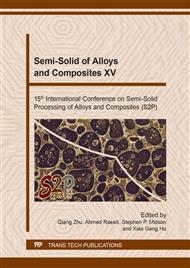[1]
D.H. Kirkwood, P. Kapranos, K. Young, M. Suery, Semi-solid Processing of Alloys, Springer- Verlag Berlin, Germany, (2009).
Google Scholar
[2]
M.C. Flemings, Behavior of metal alloy in the semisolid state, Metallurgical Transactions, 22 (1991) 957-981.
DOI: 10.1007/bf02661090
Google Scholar
[3]
D.H. Kirkwood, Semisolid metal processing, International Materials Reviews, 39. (1994) 173-189.
Google Scholar
[4]
Z. Fan, Semisolid metal processing, International Materials Reviews, 47 (2002) 49-85.
Google Scholar
[5]
C. Gil Kang, C. Kyu Jin, A. Bolouri, Semisolid forming of thin plates with microscale features, Procedia Engineering, 81 (2014) 63-73.
DOI: 10.1016/j.proeng.2014.09.129
Google Scholar
[6]
M.C. Flemings, R.G. Rieck, K.P. Young, Rheocasting, Materials Science and Engineering, 25 (1976) 103 – 117.
Google Scholar
[7]
M.C. Flemings, Solidification Processing, McGraw-Hill, New York, (1974).
Google Scholar
[8]
R.D. Doherty, H.I. Lee, E.A. Feest, Microstructure of stir-cast metals, Materials Science and Engineering, 65 (1984) 181-189.
DOI: 10.1016/0025-5416(84)90211-8
Google Scholar
[9]
A. Hellawell, Grain evolution in convection and rheo-casting, Proceedings of the 4th International Conference on semisolid processing of Alloy and Composition, University of Sheffield,UK, (1996).
Google Scholar
[10]
M. Reisi, B. Niroumand, On the dilemma of shear and flow requirements for the evolution of semisolid microstructures, Materials Letters, 68 (2012) 317–319.
DOI: 10.1016/j.matlet.2011.10.057
Google Scholar
[11]
R. Elliot, Eutectic Solidification Process, Butterworth, London, (1983).
Google Scholar
[12]
B. Chalmers, Principles of Solidification, Wiley, New York, (1964).
Google Scholar
[13]
Y. Xiao-Rong, M. Wei-Min, S. Bin-Yu, Preparation of semisolid A356 alloy slurry with larger capacity cast by serpentine channel, Transactions of Nonferrous Metals Society of China, 21 (2011) 455−460.
DOI: 10.1016/s1003-6326(11)60736-x
Google Scholar
[14]
S. Cheng, Y. Zhao, H. Hou, Y. Jin, X. Guo, Preparation of semi-solid ZL101 aluminum alloy slurry by serpentine channel, Transactions of Nonferrous Metals Society of China. 26 (2016) 1820-1825.
DOI: 10.1016/s1003-6326(16)64293-0
Google Scholar
[15]
L. Chen, Y. Zhao, F. Yan, H. Hou, Statistical investigations of serpentine channel pouring process parameters on semi-solid ZL101 aluminum alloy slurry using response surface methodology, Journal of Alloys and Compounds, 25 (2017) 673-683.
DOI: 10.1016/j.jallcom.2017.07.169
Google Scholar
[16]
Z. Zheng, Y. Ji, W. Mao, R. Yue, Z. Liu, Influence of rheo-diecasting processing parameters on microstructure and mechanical properties hypereutectic Al-30%Si alloy, Transactions of Nonferrous Metals Society of China, 27 (2017) 1264-1272.
DOI: 10.1016/s1003-6326(17)60147-x
Google Scholar
[17]
Z.K. Zheng, W.M. Mao, Z.Y. Liu, D. Wang, R. Yue, Refinement of primary Si grains in Al–20%Si alloy slurry through serpentine channel pouring process, International Journal of Minerals, Metallurgy and Materials, 23 (2016) 572-580.
DOI: 10.1007/s12613-016-1268-2
Google Scholar
[18]
Z. Liu, W. Mao, W. Wang and Z. Zheng, Preparation of semi-solid A380 aluminum alloy slurry by serpentine channel, Transactions of Nonferrous Metals Society of China, 25 (2015) 1419-1426.
DOI: 10.1016/s1003-6326(15)63741-4
Google Scholar
[19]
Z. Chen, W. Mao and Z. Wu, Preparation of semi-solid aluminum alloy slurry poured through a water-cooled serpentine channel, International Journal of Minerals, Metallurgy and Materials, 19 (2012) 48-53.
DOI: 10.1007/s12613-012-0513-6
Google Scholar
[20]
Z. Chen, W. Mao, Z. Wu, Influence of serpentine channel pouring process parameters on semi-solid A356 aluminum alloy slurry, Transactions of Nonferrous Metals Society of China, 21 (2011) 985-990.
DOI: 10.1016/s1003-6326(11)60810-8
Google Scholar
[21]
F. Marani, Semisolid casting of Zamak 3 alloy using modified serpentine channel and characterization of its microstructural and mechanical properties, MSc thesis, Isfahan University of Technology, (2018).
Google Scholar
[22]
U.A. Curle, H. Moller and J.D. Wilkins, Shape rheocasting of high purity aluminium, Scripta Materialia, 64 (2011) 479-482.
DOI: 10.1016/j.scriptamat.2010.11.010
Google Scholar
[23]
X.P. Sun, L. Shi, R.G. Guan, S.C. Wang, W.J. Qi, Study progress and new trends of grain refinement in aluminum alloys, Non-Ferrous Mining and Metallurgy., 26 (2010) 32.
Google Scholar


